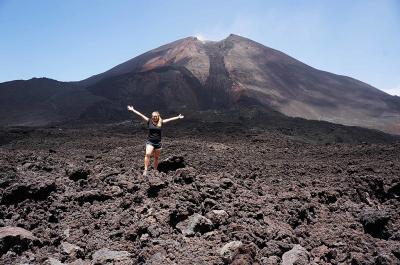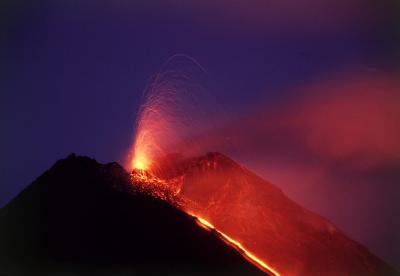Overview
Pacaya is an active complex volcano in Guatemala, which first erupted approximately 23,000 years ago and has erupted at least 23 times since the Spanish invasion of Guatemala. Pacaya rises to an elevation of 2,552 metres.
Description
The Pacaya Volcano’s current active phase began in 1965. Much to the delight of travelers, the volcano continues to spew ash and lava from its top. The activity can vary from quiet gas and steam emissions to larger explosions of rocks and lava. Night is the best time for viewing eruptions, as you can see fountains of fiery orange lava spewing from the top of the volcano.
Pacaya is one of Central America’s most accessible volcanoes. Although it can be hiked independently, guides are recommended. Most tour operators are based in Antigua, but it’s possible to hike Pacaya as a daytrip from Guatemala City as well.
The trailhead is in the village of San Francisco de Sales. The park’s trails are well maintained and have good signage, restrooms, trash bins, and rest stops. Park rangers have virtually eliminated all incidents of robbery.
The steep, 2.3-mile (3.7-km) trail up Pacaya climbs steadily through farmland and secondary forest before arriving on an exposed ridge covered with old lava flows. There are good views of the smoking black cone from here. The trail then crosses the ridge and winds up the volcanic crater—it can be tough work hiking up the loose ash, so be ready for a solid workout. Once you reach the summit you’ll be rewarded with face-to-face views of the volcano’s main vent, which may be belching ash, rocks, or lava.
Although the climb up Pacaya is fairly safe, it’s important to remember a few precautions. The summit can be windy and the vents emit sulfurous fumes, which should be avoided if possible. Be careful of slow-moving lava flows and hot zones beneath your feet. The descent down the cone can be tricky and slippery. Go slow—you don’t want to land face-first on a sharp volcanic rock.
If you do decide to hike the Pacaya Volcano, bring water and snacks. Sturdy shoes, sunscreen, a hat, rain gear, and a camera are also recommended.
Antigua, Escuintla
Guatemala
URL:
http://www.anywhere.com/guatemala/attractions/pacaya-volcano-volcano


